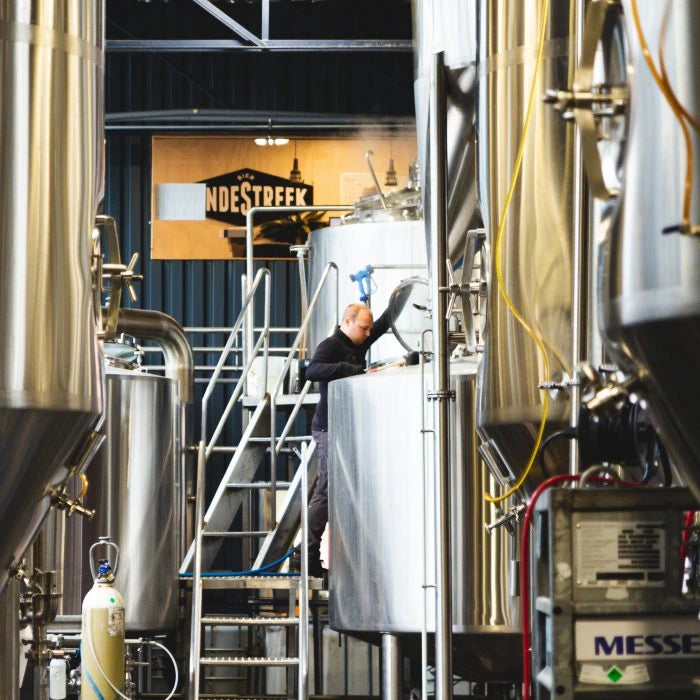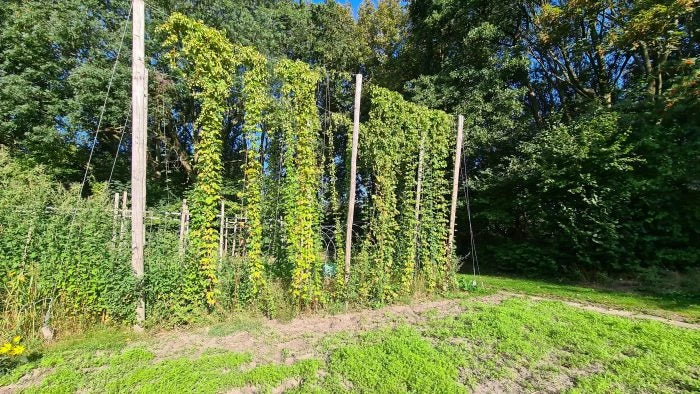- News
- /
Brewing – how does it actually work?

The story goes that brewing once started with bread that got wet and started to ferment. Someone who was very hungry went to eat it and it probably made me happy. After that it was a matter of repeating that process and experimenting with it, with additions for the taste. The latter still happens, but the brewing process has now become more transparent. We go through the steps we take every day with you.
To clean
Brewing is cleaning. That's what we're working on the most. If you don't like cleaning, don't brew. All equipment used must be clean; all tanks, pipes, filters, taps, etc. You've got it: absolutely everything has to be clean. If that is not the case and yeast cells or bacteria are still living somewhere, an infection can occur and the beer will turn sour. Then your work has been for nothing.
scrap
Before we start brewing, we scrap the malt. This means that we crush the malt into small pieces with a scrap mill. Not too small, because that will not filter properly. It is about separating the wheat from the chaff so that the water will soon reach the starches and the enzymes can do their job.
mash
In the mash tun, starches from the malt and grains are converted into sugars. This happens at a temperature between 57 and 72 degrees Celsius. We pour the malt and mix it with the water into a nice batter. It is important to check the acidity of the batter and, if necessary, correct it to the correct pH value. The purpose of mashing is to activate the enzymes from the malt. They ensure that proteins dissolve, which are necessary for the foam head. Starch is also broken down into sugars, which is the food for the yeast.
The mashing can be done in different steps, with different temperatures to activate the so-called amylases. Playing with the temperature then gives different fermentable and unfermentable sugars. vandeStreek bier often mashes at one temperature, between 65 and 72 degrees, making the balance between fermentable and unfermentable sugars ideal. The batter is continuously stirred during this process. To stop the process, we raise the temperature to 78 degrees. Then the action of the enzymes stops.
Filter
When all the starch has been converted to sugars, the liquid must be separated from the used malt. The mash is pumped to the lauter tun. It has a double bottom through which the wort, a sweet liquid, runs to the boiling kettle. The chaff of the grain acts as a filter layer here. Because a lot of sugar-rich moisture remains in the residual product – spent grains – we add extra water during the filtering. The bostel goes to farmer Jan in Groenekan to feed his goats. The goat cheeses served in our tasting room are made with goat's milk from farmer Jan.

Cook
The wort is then brought to a boil. Boiling the wort evaporates certain substances that potentially make the beer taste like vegetables. Hops are added for the first time during boiling. This first hop provides the bitterness. The more hops, the more bitter the beer becomes. Cooking also creates a sterile environment. Last but not least, we ensure that proteins flocculate during cooking. Protein is good for the head, but not good for your fermentation.
Hop gift and herbal bales
In general, the warmer the hops are added, the more bitters they give off. The more it is added on the cold side, the more aroma. The bittering hop is therefore added during the boil. We only add the aroma hops in the next step, in the whirlpool.
Although only four basic ingredients are needed for beer, there are brewers who believe that you can cook anything you want with it. Sometimes that provides a nice extra flavor, sometimes it's a marketing gimmick. So in this phase you can add your chocolate, coffee, tea, white beans in tomato sauce, bacon, mango puree, chili peppers, etc.
Whirlpool
With the addition of the hops or other flavourings, solid parts have returned to the liquid and it is necessary to separate them. That is done with the whirlpool. There, the wort is introduced at an angle, creating a centrifugal force that causes all solids to accumulate in the center of the tank. (You can replicate this effect at home by vigorously stirring a glass of loose tea.) The clear wort is then drained and sent to the plate cooler.
Cooling
The warm wort must be cooled before the yeast can be added. From the whirlpool, the wort is passed through a plate cooler. Cold water runs through the walls, cooling warm wort from 85 degrees to the fermentation temperature. The water from the plate cooler takes over the heat from the wort and that hot water can be used again for the next brew. The cooled wort goes from the plate cooler to the fermentation tank.
Fermentation and lagering
The yeast is added in the fermentation tank. The main fermentation usually lasts one to one and a half weeks. The contents of the tank are then cooled to 2 degrees Celsius to lower the beer.
Dry hopping
At the end of the fermentation, or just afterwards, we can add aroma hops with which we can add the desired smell and taste to the beer. This is how we provide those tropical fruit scents and flavors.
Filling
The last step in the brewing process is filling. In cask, bottle, can, just what you need as a brewer to get your beer to the enthusiast. Or just what suits your quality or sustainability wishes. And then you end with a nice beer. But not before you have thoroughly repeated step one - cleaning - again.


